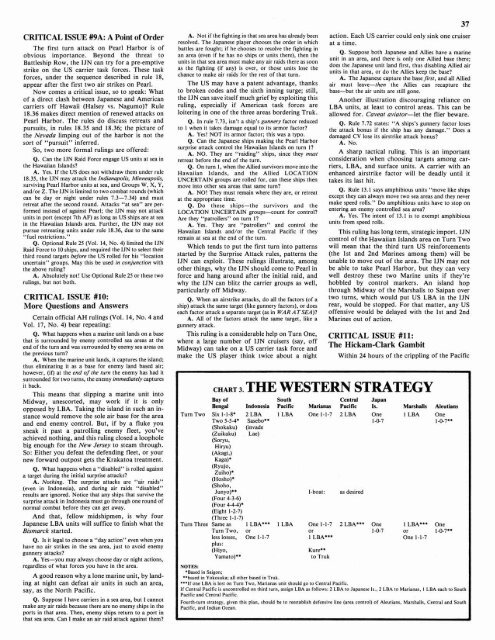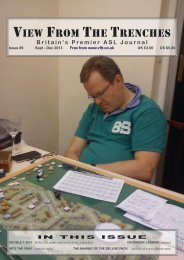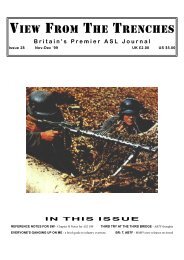18.64MB - View From The Trenches
18.64MB - View From The Trenches
18.64MB - View From The Trenches
- TAGS
- trenches
- www.vftt.co.uk
You also want an ePaper? Increase the reach of your titles
YUMPU automatically turns print PDFs into web optimized ePapers that Google loves.
CRITICAL ISSUE #9A: A Point of Order<br />
<strong>The</strong> first turn attack on Pearl Harbor is of<br />
obvious importance. Beyond the threat to<br />
Battleship Row, the IJN can try for a pre-emptive<br />
strike on the US carrier task forces. <strong>The</strong>se task<br />
forces, under the sequence described in rule 18,<br />
appear after the first two air strikes on Pearl.<br />
Now comes a critical issue, so to speak: What<br />
of a direct clash between Japanese and American<br />
carriers off Hawaii (Halsey vs. Nagumo)? Rule<br />
18.36 makes direct mention of renewed attacks on<br />
Pearl Harbor. <strong>The</strong> rules do discuss retreats and<br />
pursuits, in rules 18.35 and 18.36; the picture of<br />
the Nevada limping out of the harbor is not the<br />
sort of "pursuit" inferred.<br />
So, two more formal rulings are offered:<br />
Q. Can the IJN Raid Force engage US units at sea in<br />
the Hawaiian Islands?<br />
A. Yes. If the US does not withdraw them under rule<br />
18.35, the IJN may attack the Indianapolis, Minneapolis,<br />
surviving Pearl Harbor units at sea, and Groups W, X, Y,<br />
and/or 2. <strong>The</strong> 1JN is limited to two combat rounds (which<br />
can be day or night under rules 7.3-7.34) and must<br />
retreat after the second round. Attacks "at sea" are per-<br />
formed instead of against Pearl; the IJN may not attack<br />
units in port (except 7th AF) as long as US ships are at sea<br />
in the Hawaiian Islands area. Further, the IJN may not<br />
pursue retreating units under rule 18.36, due to the same<br />
"fuel restrictions."<br />
Q. Optional Rule 25 (Vol. 14, No. 4) limited the IJN<br />
Raid Force to 10 ships, and required the IJN to select their<br />
third round targets before the US rolled for his "location<br />
uncertain" groups. May this be used in conjunction with<br />
the above ruling?<br />
A. Absolutely not! Use Optional Rule 25 or these two<br />
rulings, but not both.<br />
CRITICAL ISSUE #lo:<br />
More Questions and Answers<br />
Certain official AH rulings (Vol. 14, No. 4 and<br />
Vol. 17, No. 4) bear repeating:<br />
Q. What happens when a marine unit lands on a base<br />
that is surrounded by enemy controlled sea areas at the<br />
end of the turn and was surrounded by enemy sea areas on<br />
the previous turn?<br />
A. When the marine unit lands, it captures the island;<br />
thus eliminating it as a base for enemy land based air;<br />
however, (if) at the end of the turn the enemy has had it<br />
surrounded for two turns, the enemy immediately captures<br />
it back.<br />
This means that slipping a marine unit into<br />
Midway, unescorted, may work if it is only<br />
opposed by LBA. Taking the island in such an in-<br />
stance would remove the sole air base for the area<br />
and end enemy control. But, if by a fluke you<br />
sneak it past a patrolling enemy fleet, you've<br />
achieved nothing, and this ruling closed a loophole<br />
big enough for the New Jersey to steam through.<br />
So: Either you defeat the defending fleet, or your<br />
new forward outpost gets the Krakatoa treatment.<br />
Q. What happens when a "disabled" is rolled against<br />
a target during the initial surprise attacks?<br />
A. Nothing. <strong>The</strong> surprise attacks are "air raids"<br />
(even in Indonesia), and during air raids "disabled"<br />
results are ignored. Notice that any ships that survive the<br />
surprise attack in Indonesia must go through one round of<br />
normal combat before they can get away.<br />
And that, fellow midshipmen, is why four<br />
Japanese LBA units will suffice to finish what the<br />
Bismarck started.<br />
Q. Is it legal to choose a "day action" even when you<br />
have no air strikes in the sea area, just to avoid enemy<br />
gunnery attacks?<br />
A. Yes-you may always choose day or night actions,<br />
regardless of what forces you have in the area.<br />
A good reason why a lone marine unit, by land-<br />
ing at night can defeat air units in such an area,<br />
say, as the North Pacific.<br />
Q. Suppose I have carriers in a sea area, but I cannot<br />
make any air raids because there are no enemy ships in the<br />
ports in that area. <strong>The</strong>n, enemy ships return to a port in<br />
that sea area. Can I make an air raid attack against them?<br />
A. Not if the fighting in that sea area has already been<br />
resolved. <strong>The</strong> Japanese player chooses the order in which<br />
battles are fought; if he chooses to resolve the fighting in<br />
an area (even if he has no ships or units there), then the<br />
units in that sea area must make any air raids there as soon<br />
as the fighting (if any) is over, or those units lose the<br />
chance to make air raids for the rest of that turn.<br />
<strong>The</strong> US may have a patent advantage, thanks<br />
to broken codes and the sixth inning surge; still,<br />
the IJN can save itself much grief by exploiting this<br />
ruling, especially if American task forces are<br />
loitering in one of the three areas bordering Truk.<br />
Q. In rule 7.73, isn't a ship's gunnery factor reduced<br />
to 1 when it takes damage equal to its armor factor?<br />
A. Yes! NOT its armor factor; this was a typo.<br />
Q. Can the Japanese ships making the Pearl Harbor<br />
surprise attack control the Hawaiian Islands on turn I?<br />
A. NO. <strong>The</strong>y are "raiding" ships, since they must<br />
retreat before the end of the turn.<br />
Q. On turn 1, when the Allied survivors move into the<br />
Hawaiian Islands, and the Allied LOCATION<br />
UNCERTAIN groups are rolled for, can these ships then<br />
move into other sea areas that same turn?<br />
A. NO! <strong>The</strong>y must remain where they are, or retreat<br />
at the appropriate time.<br />
Q. Do these ships-the survivors and the<br />
LOCATION UNCERTAIN groups-count for control?<br />
Are they "patrollers" on turn l?<br />
A. Yes. <strong>The</strong>y are "patrollers" and control the<br />
Hawaiian Islands and/or the Central Pacific if they<br />
remain at sea at the end of the turn.<br />
Which tends to put the first turn into patterns<br />
started by the Surprise Attack rules, patterns the<br />
IJN can exploit. <strong>The</strong>se rulings illustrate, among<br />
other things, why the IJN should come to Pearl in<br />
force and hang around after the initial raid, and<br />
why the IJN can blitz the carrier groups as well,<br />
particularly off Midway.<br />
Q. When an airstrike attacks, do all the factors (of a<br />
ship) attack the same target (like gunnery factors), or does<br />
each factor attack a separate target (as in WAR ATSEA)?<br />
A. All of the factors attack the same target, like a<br />
gunnery attack.<br />
This ruling is a considerable help on Turn One,<br />
where a large number of IJN cruisers (say, off<br />
Midway) can take on a US carrier task force and<br />
make the US player think twice about a night<br />
action. Each US carrier could only sink one cruiser<br />
at a time.<br />
Q. Suppose both Japanese and Allies have a marine<br />
unit in an area, and there is only one Allied base there;<br />
does the Japanese unit land first, thus disabling Allied air<br />
units in that area, or do the Allies keep the base?<br />
A. <strong>The</strong> Japanese capture the basefirst, and all Allied<br />
air must leave-then the Allies can recapture the<br />
base-but the air units are still gone.<br />
Another illustration discouraging reliance on<br />
LBA units, at least to control areas. This can be<br />
allowed for. Caveat aviator-let the flier beware.<br />
Q. Rule 7.72 states: "A ships's gunnery factor loses<br />
the attack bonus if the ship has any damage." Does a<br />
damaged CV lose its airstrike attack bonus?<br />
A. No.<br />
A sharp tactical ruling. This is an important<br />
consideration when choosing targets among car-<br />
riers, LBA, and surface units. A carrier with an<br />
enhanced airstrike factor will be deadly until it<br />
takes its last hit.<br />
Q. Rule 13.1 says amphibious units "move like ships<br />
except they can always move two sea areas and they never<br />
make speed rolls." Do amphibious units have to stop on<br />
entering an enemy controlled sea area?<br />
A. Yes. <strong>The</strong> intent of 13.1 is to exempt amphibious<br />
units from speed rolls.<br />
This ruling has long term, strategic import. IJN<br />
control of the Hawaiian Islands area on Turn Two<br />
will mean that the third turn US reinforcements<br />
(the 1st and 2nd Marines among them) will be<br />
unable to move out of the area. <strong>The</strong> IJN may not<br />
be able to take Pearl Harbor, but they can very<br />
well destroy these two Marine units if they're<br />
hobbled by control markers. An island hop<br />
through Midway of the Marshalls to Saipan over<br />
two turns, which would put US LBA in the IJN<br />
rear, would be stopped. For that matter, any US<br />
offensive would be delayed with the 1st and 2nd<br />
Marines out of action.<br />
CRITICAL ISSUE #11:<br />
<strong>The</strong> Hickam-Clark Gambit<br />
I-boat: as desired<br />
Within 24 hours of the crippling of the Pacific<br />
CHART 3. THE WESTERN STRATEGY<br />
Bay of South Central Japan<br />
Bengal Indonesia Pacific Marianas Pacific Is. Marshalls Aleutians<br />
Turn Two Six 1-1-8. 2 LBA 1 LBA One 1-1-7 2 LBA One l LBA One<br />
Two 5-5-4' Sasebo8* 1-0-7 1-0-7''<br />
(Shokaku) (invade<br />
(Zuikaku) Lae)<br />
(Sor~u,<br />
Hiryu)<br />
(Akagi,)<br />
Kaga)*<br />
(Ryu~o,<br />
Zuiho)*<br />
(Hosho)*<br />
(Shoho,<br />
Junyo)**<br />
(Four 4-3-6)<br />
(Four 4-4-4)'<br />
(Eight 1-2-7)<br />
(Three 1-1-7)<br />
Turn Three Same as I LBA8** 1 LBA One 1-1-7 2 LBA*** One I LBA8** One<br />
Turn Two, or or 1-0-7 or 1-0-7**<br />
less losses, One 1-1-7 1 LBA8** One 1-1-7<br />
plus:<br />
(Hiyo, Kure8*<br />
Yamato)** to Truk<br />
NOTES:<br />
'Based in Saigon;<br />
**based in Yokosuka; all other based in Truk.<br />
***If one LBA is lost on Turn Two, Marianas unit should go to Central Pacific.<br />
If Central Pacific is uncontrolled on third turn, assign LBA as follows: 2 LBA to Japanese Is., 2 LBA to Marianas, 1 LBA each to South<br />
Pacific and Central Pacific.<br />
Fourth-turn strategy, given this plan, should he to reestablish defensive line (area control) of Aleutians, Marshalls, Central and South<br />
Pacific, and Indian Ocean.<br />
4<br />
h
















